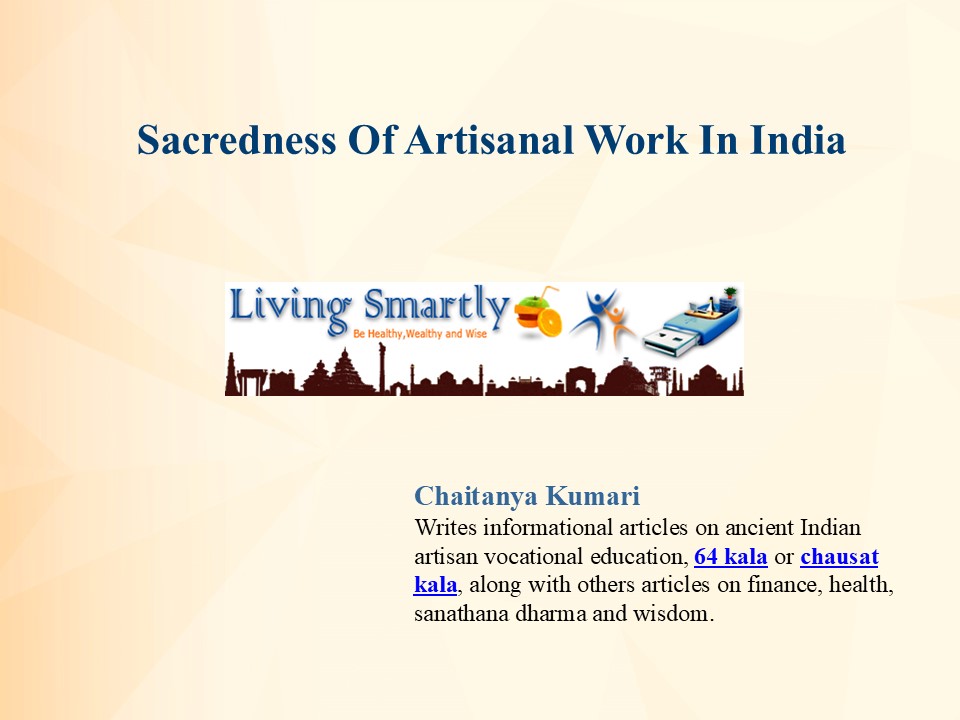Sacredness Of Artisanal Work In India
Title:
Sacredness Of Artisanal Work In India
Description:
Traditionally, all forms of artisanal work in India were considered as art, and artisans were treated with the utmost respect. The number of crafts and arts in India is well over 3000; all the artworks testify to the exceptional skills of Indian artisans. Every zone of India has a craft/art that is unique to it. In all artisanal families, the abilities and skills are transferred to subsequent generations. –
Number of Views:0
Title: Sacredness Of Artisanal Work In India
1
Sacredness Of Artisanal Work In India
Chaitanya Kumari Writes informational articles on
ancient Indian artisan vocational education, 64
kala or chausat kala, along with others articles
on finance, health, sanathana dharma and wisdom.
2
Traditionally, all forms of artisanal work in
India were considered as art, and artisans were
treated with the utmost respect. The number of
crafts and arts in India is well over 3000 all
the artworks testify to the exceptional skills of
Indian artisans. Every zone of India has a
craft/art that is unique to it. In all artisanal
families, the abilities and skills are
transferred to subsequent generations. As a
result, there were closely-knit artisan
communities where the members complemented each
other in creating excellent works of art. Here,
the salient aspect is that, historically,
artisanal work has been rated as a sacred one in
India. The artisans also approached their job by
treating it as a way of expressing their devotion
to God. Let us now succinctly focus on some
important, related aspects.
3
- The artisans in India of that era never thought
that their craft was only a source of livelihood
for them. These skilled people strongly believed
that the work that they do has a spiritual angle
to it. It is something that takes them closer to
God. - In ancient India, artisans used to design various
kinds of items for different purposes. On one
hand, they would make utility items that are
required for everyday life. In the same way, they
created objects for various rites and rituals
pertaining to both happy and sad occasions.
Weddings, childbirth, initiation, and death are a
few occasions where many rituals are performed. - The craftspeople would make suitable items with
total devotion, understanding the significance of
the occasion. This again reflects the sacredness
of artisanal work in age-old India. People who o
ahead and buy the artworks of these talented
artisans display reverence towards the sanctity
of artisanal work. - The Indian artisans designed varied objects
making use of only their hands they were fully
knowledgeable about the properties of all the
materials used. The topmost dedication with which
they created items subtly conveys that this work
was worshiped for them. This contributes to the
sacredness of this activity.
4
- When a skilled expert toils to that extent
depending just on their hands, their abilities
and experience become esteemed. And that is
exactly what these artisans got from people
respect. - The artisanal activities in ancient India
included carvings developed from metal and stone,
pottery, textile works, painting, jewelry work,
and block printing. These artisans made sure that
the objects made by them mirrored the vast
cultural heritage of India. As the pieces of art
represent diverse traditions and cultures, it is
logical that the work involved in making them is
considered holy. - In the pre-colonial phase, the crafts and arts of
India were renowned throughout the world. The
artworks were exported to diverse regions of the
globe in that era, India gained recognition as
the leading exporter. This was primarily
attributable to the fact that, for the Indian
craftspeople, their work was not just a
profession. It was an activity that made them
experience spiritual fulfillment.
5
- As per Hindu scriptures, the thunderbolt used as
a weapon by Lord Indra was made by Tvasta, who is
known as a divine artisan. The Puranas add that
gods are responsible for bringing into existence
various aspects of the world. Yet, the gods
themselves depended on the craft skills of
Tvasta. This highlights how important the
position of artisans was in ancient Indian
society.
6
Thank you for spending your precious time
in reading this article!
About Living Smartly
Living-smartly.com is a website that publishes
information specifically focused on helping
people to make right choices in their every day
challenges. Living Smartly provides smart tips
insights that covers all aspects of daily living
such as general health dental health,
philosophy, social skills, technology, wellness,
gifts etc.































